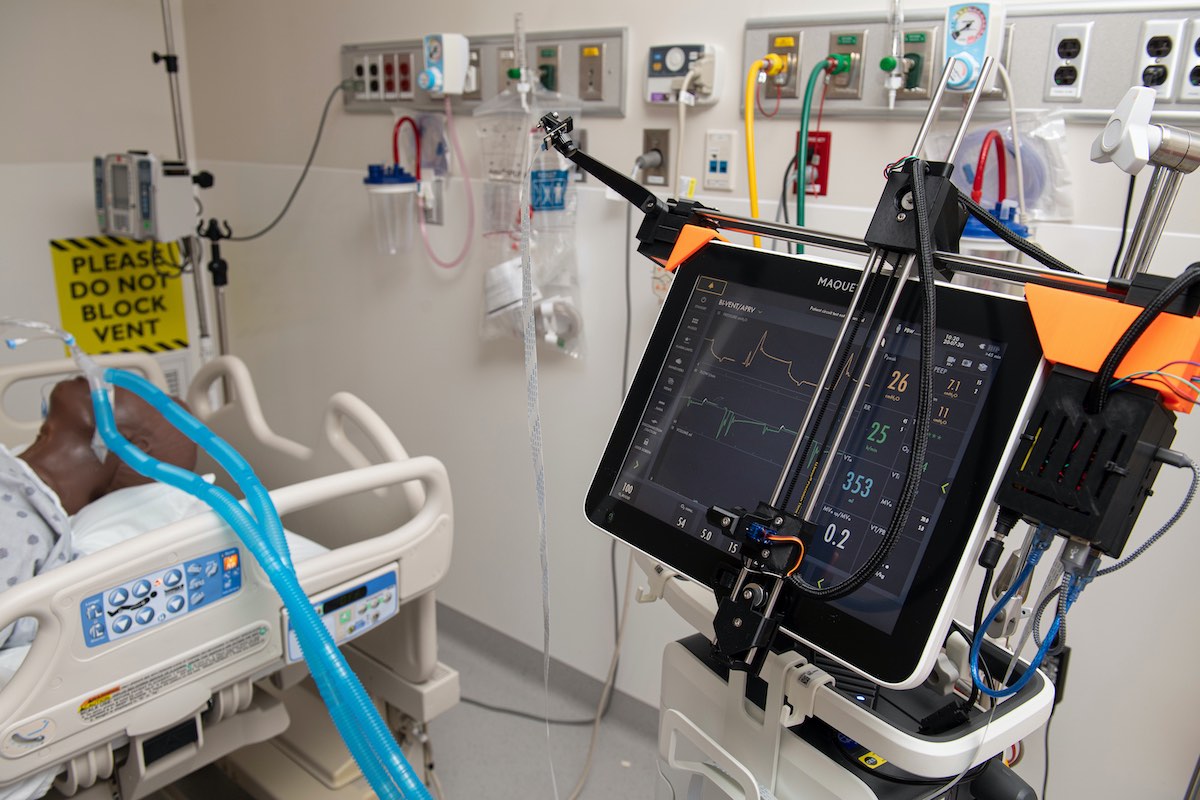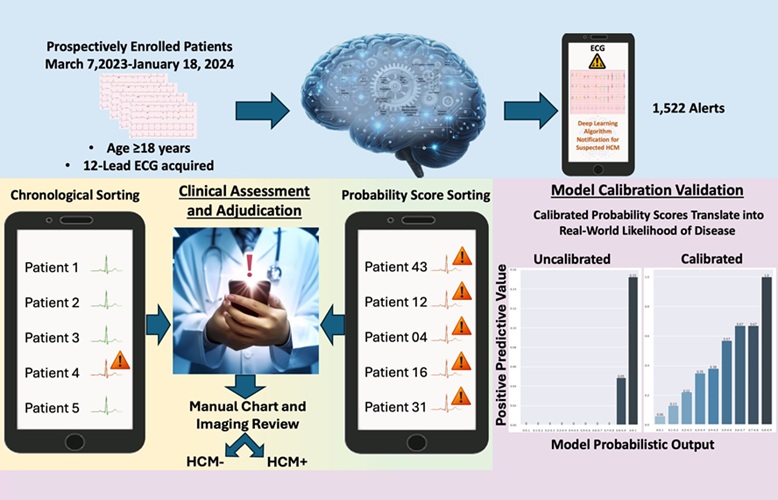Robotic System Remotely Operates Ventilators in COVID-19 Wards 
|
By HospiMedica International staff writers Posted on 25 Aug 2020 |

Image: A robotic assistant adjusts ventilator parameters remotely (Photo courtesy of JHU)
A new robotic system allows medical staff to remotely operate ventilators and other bedside machines from outside intensive care rooms of patients suffering from infectious diseases.
Developed at Johns Hopkins University (JHU; Baltimore, MD, USA) and Johns Hopkins Medicine (JHM; Baltimore, MD, USA), the robotic device is affixed to the ventilator's touch screen with a horizontal bar that is secured across the top edge. The bar serves as a stationary track for the back-and-forth movement of two connected vertical bars that extend the full height of the screen. As the vertical bars sweep across the screen, a stylus they carry moves up and down according to its commands, similar to how an Etch A Sketch moves its drawing tool along an X-Y axis.
A camera connected to the top bar sends an image of the screen to the operator's tablet outside the room. The system is still being tested, but in initial trials at the Johns Hopkins Hospital biocontainment unit, a tablet was used to remotely change oxygen percentage and volume delivered by a ventilator to a mannequin in an adjoining room. According to the developers, the robotic system can be deployed to help hospitals preserve protective gear, limit staff exposure to COVID-19, and provide more time for clinical work.
“Routine adjustments typically take just a couple minutes inside a room. But putting on and removing gear added an additional six minutes to the process. Doing that 10 times in a single shift steals an entire hour that could have been spent delivering patient care,” said respiratory therapist Jonathan Cope, who assisted with the project. “This remote-control system will be a force multiplier for our frontline clinicians. Being able to save time to deliver more care to more patients will pay huge dividends when we face massive patient surges during pandemicsm.”
The COVID-19 pandemic spurred a surge of highly infectious patients requiring ventilators, infusion pumps, and other equipment. Treating such intensive care patients requires personnel to don and doff personal protective equipment (PPE) every time, even for minor adjustments to machines. The process burns through limited supplies, and also wastes valuable time and personnel as the procedure requires an additional person to assist with the changing of gowns, gloves, masks, and other gear.
Related Links:
Johns Hopkins University
Johns Hopkins Medicine
Developed at Johns Hopkins University (JHU; Baltimore, MD, USA) and Johns Hopkins Medicine (JHM; Baltimore, MD, USA), the robotic device is affixed to the ventilator's touch screen with a horizontal bar that is secured across the top edge. The bar serves as a stationary track for the back-and-forth movement of two connected vertical bars that extend the full height of the screen. As the vertical bars sweep across the screen, a stylus they carry moves up and down according to its commands, similar to how an Etch A Sketch moves its drawing tool along an X-Y axis.
A camera connected to the top bar sends an image of the screen to the operator's tablet outside the room. The system is still being tested, but in initial trials at the Johns Hopkins Hospital biocontainment unit, a tablet was used to remotely change oxygen percentage and volume delivered by a ventilator to a mannequin in an adjoining room. According to the developers, the robotic system can be deployed to help hospitals preserve protective gear, limit staff exposure to COVID-19, and provide more time for clinical work.
“Routine adjustments typically take just a couple minutes inside a room. But putting on and removing gear added an additional six minutes to the process. Doing that 10 times in a single shift steals an entire hour that could have been spent delivering patient care,” said respiratory therapist Jonathan Cope, who assisted with the project. “This remote-control system will be a force multiplier for our frontline clinicians. Being able to save time to deliver more care to more patients will pay huge dividends when we face massive patient surges during pandemicsm.”
The COVID-19 pandemic spurred a surge of highly infectious patients requiring ventilators, infusion pumps, and other equipment. Treating such intensive care patients requires personnel to don and doff personal protective equipment (PPE) every time, even for minor adjustments to machines. The process burns through limited supplies, and also wastes valuable time and personnel as the procedure requires an additional person to assist with the changing of gowns, gloves, masks, and other gear.
Related Links:
Johns Hopkins University
Johns Hopkins Medicine
Latest Patient Care News
- Portable Biosensor Platform to Reduce Hospital-Acquired Infections
- First-Of-Its-Kind Portable Germicidal Light Technology Disinfects High-Touch Clinical Surfaces in Seconds
- Surgical Capacity Optimization Solution Helps Hospitals Boost OR Utilization

- Game-Changing Innovation in Surgical Instrument Sterilization Significantly Improves OR Throughput
- Next Gen ICU Bed to Help Address Complex Critical Care Needs
- Groundbreaking AI-Powered UV-C Disinfection Technology Redefines Infection Control Landscape
- Clean Hospitals Can Reduce Antibiotic Resistance, Save Lives
- Smart Hospital Beds Improve Accuracy of Medical Diagnosis
- New Fast Endoscope Drying System Improves Productivity and Traceability
- World’s First Automated Endoscope Cleaner Fights Antimicrobial Resistance
- Portable High-Capacity Digital Stretcher Scales Provide Precision Weighing for Patients in ER
- Portable Clinical Scale with Remote Indicator Allows for Flexible Patient Weighing Use
- Innovative and Highly Customizable Medical Carts Offer Unlimited Configuration Possibilities
- Biomolecular Wound Healing Film Adheres to Sensitive Tissue and Releases Active Ingredients
- Wearable Health Tech Could Measure Gases Released From Skin to Monitor Metabolic Diseases
- Wearable Cardioverter Defibrillator System Protects Patients at Risk of Sudden Cardiac Arrest
Channels
Critical Care
view channel
Smart Bandage Monitors Chronic Wounds in Human Patients
A future smart bandage, envisioned as a "lab on skin," could assist both patients and caregivers by not only monitoring chronic wounds but also delivering treatment and accelerating the healing process... Read more
AI Identifies Patients with Increased Lung Cancer Risk Up To 4 Months Earlier
Earlier diagnosis plays a crucial role in improving the prognosis of cancer, as delays in starting therapy are associated with decreased survival rates. In most cases, cancer is first identified when symptoms... Read more
AI Algorithm Identifies High-Risk Heart Patients
Hypertrophic cardiomyopathy (HCM) is a complex condition characterized by the thickening of the heart muscle, which impairs the heart's ability to pump blood effectively. This forces the heart to work... Read more
Next Gen Hemodynamic Monitoring Solution Provides AI-Driven Clinical Decision Support
A new cutting-edge hemodynamic monitoring platform, equipped with predictive artificial intelligence (AI)-based algorithms, is designed to help clinicians proactively manage blood pressure fluctuations... Read moreSurgical Techniques
view channel
DNA Origami Improves Imaging of Dense Pancreatic Tissue for Cancer Detection and Treatment
One of the challenges of fighting pancreatic cancer is finding ways to penetrate the organ’s dense tissue to define the margins between malignant and normal tissue. Now, a new study uses DNA origami structures... Read more
Pioneering Sutureless Coronary Bypass Technology to Eliminate Open-Chest Procedures
In patients with coronary artery disease, certain blood vessels may be narrowed or blocked, requiring a stent or a bypass (also known as diversion) to restore blood flow to the heart. Bypass surgeries... Read more
Intravascular Imaging for Guiding Stent Implantation Ensures Safer Stenting Procedures
Patients diagnosed with coronary artery disease, which is caused by plaque accumulation within the arteries leading to chest pain, shortness of breath, and potential heart attacks, frequently undergo percutaneous... Read more
World's First AI Surgical Guidance Platform Allows Surgeons to Measure Success in Real-Time
Surgeons have always faced challenges in measuring their progress toward surgical goals during procedures. Traditionally, obtaining measurements required stepping out of the sterile environment to perform... Read moreHealth IT
view channel
Printable Molecule-Selective Nanoparticles Enable Mass Production of Wearable Biosensors
The future of medicine is likely to focus on the personalization of healthcare—understanding exactly what an individual requires and delivering the appropriate combination of nutrients, metabolites, and... Read more
Smartwatches Could Detect Congestive Heart Failure
Diagnosing congestive heart failure (CHF) typically requires expensive and time-consuming imaging techniques like echocardiography, also known as cardiac ultrasound. Previously, detecting CHF by analyzing... Read moreBusiness
view channel
Expanded Collaboration to Transform OR Technology Through AI and Automation
The expansion of an existing collaboration between three leading companies aims to develop artificial intelligence (AI)-driven solutions for smart operating rooms with sophisticated monitoring and automation.... Read more















